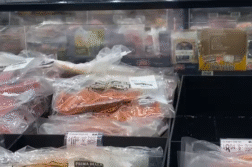DENVER, Colo. (Ivanhoe Newswire) – Each week in the U.S., almost 70,000 babies are born premature. That means the baby was born before 37 weeks — full term is 40 weeks. Many times, these babies face breathing and eating problems. But what happens if the baby is born at just 23 weeks — almost half of what is considered a healthy pregnancy? Separated Esophagus
Little Harper Jacobo has come a long way. She and her twin sister Gabriella were born prematurely at just 23 weeks, weighing less than a third of a pound.
“They fit in the palms of my hand. They were very, very tiny. I mean, very small,” their mother Kayla Hatch remembers.
While both girls were small, it was Harper who was given just a one percent chance of survival when she was born. But that wasn’t the only obstacle little Harper faced.
Chief of Pediatric Surgery at the Rocky Mountain Hospital for Children, Dr. Steven Rothenberg says, “The two ends of her esophagus were separated by quite a bit. So, basically, means that she could not swallow whatsoever.”
The two ends were separated by seven centimeters.
Dr. Rothenberg led a team at Rocky Mountain Hospital for Children, performing three lifesaving surgeries on Harper. The first one, stretching the two ends to try to bring them together.
“We got the two ends almost together, but there was still about, maybe a one inch gap between the two ends,” Dr. Rothenberg explains.
Then, he took part of Harper’s chest wall to create a Band-Aid between the two ends, closing the gap to a half an inch, then he used magnets to finally bring the ends together.
Dr. Rothenberg further explains, “We put one magnet down her mouth and into the upper part of her esophagus, we put the other magnet through her gastrostomy tube. What happened over the next few days, the magnets gradually attracted to each other.”
The magnets were eventually removed by pulling them up through Harper’s mouth, no additional surgery required. And although she is delayed, doctors believe Harper will be able to grow up and eat and swallow like any other child. Dr. Rothenberg had to get special FDA-permission to use the magnets for this purpose. For Harper, they were a life-saver.
Contributors to this news report include: Marsha Lewis, Producer; Roque Correa, Videographer & Editor.
To receive a free weekly e-mail on medical breakthroughs from Ivanhoe, sign up at: http://www.ivanhoe.com/ftk
Source:
https://www.marchofdimes.org/peristats/reports/united-states/prematurity-profile
MEDICAL BREAKTHROUGHS
RESEARCH SUMMARY
TOPIC: SAVING HARPER: SMALLEST BABY TO SURVIVE A SEPARATED ESOPHAGUS!
REPORT: MB #5209
BACKGROUND: Premature birth, which is defined as birth before 37 weeks of gestation, is a major public health concern worldwide. In the United States alone, approximately one in every 10 babies is born prematurely. An estimated 15 million babies are born prematurely every year, accounting for approximately 10% of all births worldwide. Premature babies are at increased risk of a range of health complications, including respiratory distress syndrome and brain injury. These complications can lead to long-term health problems, including developmental delays and learning disabilities. While not all cases of premature birth can be prevented, there are steps that women can take to reduce their risk, such as seeking early and regular prenatal care, avoiding tobacco and drug use, and managing pre-existing health conditions.
DIAGNOSING: Diagnosing a preterm birth can be challenging, as there are often no clear symptoms until labor begins. However, there are several tests and assessments that can help to identify women at increased risk of preterm birth. Common ways used to identify a preterm birth are pelvic exams, ultrasounds, uterine monitoring, lab tests. With the help of modern technology and medical expertise, doctors can identify women at increased risk and take steps to prevent preterm delivery or prepare for an early delivery.
NEW TECHNOLOGY: Harper Jacobo was born at nearly a third of a pound and was given a one percent chance of survival when she was born. Both ends of her esophagus were separated and she was unable to swallow. Rocky Mountain Hospital for Children performed three lifesaving surgeries for Harper. Dr. Rothenberg performed complex esophagus surgery on Harper, using minimally invasive techniques to reconnect her esophagus to her stomach. The surgery involved making several small incisions in Harper’s abdomen and chest, rather than a large incision, which allowed for a faster recovery and reduced the risk of complications.
(Source:
https://magazine.hcahealthcare.com/people/colleague-qa-handle-with-care/)
FOR MORE INFORMATION ON THIS REPORT, PLEASE CONTACT:
Stephanie Sullivan
Stephanie.sullivan@HealthONEcares.com
If this story or any other Ivanhoe story has impacted your life or prompted you or someone you know to seek or change treatments, please let us know by contacting Marjorie Bekaert Thomas at mthomas@ivanhoe.com




